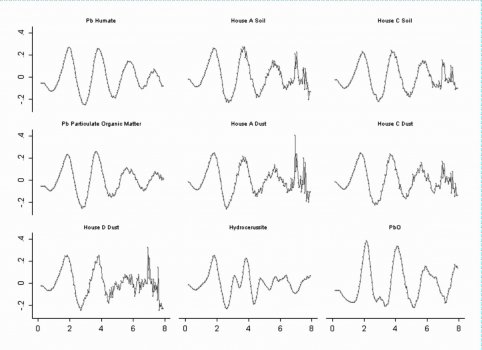The main source of high lead levels found in homes in western Sydney is not interior lead paint but lead from soils, according to a Macquarie University research investigation. Garden soils have accumulated lead mainly as a result of decades of emissions from vehicles running on leaded petrol. Other sources of lead include the deterioration of exterior leaded paint.
The preliminary findings were made by Mark Laidlaw and Mark Taylor from Macquarie University, whose international collaborators include researchers at Colorado State University and the University of Texas at El Paso. Over a 15-month period, Mark and Mark collected data from paint samples, surface and subsurface soils, interior dust collected by vacuum cleaning, settled interior and attic dust, and exterior atmospheric dust obtained from four inner western Sydney houses and one in an area of low density bushland 28 kilometres northwest of Sydney. None of the houses had exterior paint, except on gutters and windows.
Mark and Mark analysed their samples for total metal content (arsenic, cadmium, chromium, copper, lead, mercury, nickel and zinc) and lead isotopes, and used x-ray absorption spectroscopy at the Australian Synchrotron to obtain lead spectra from each sample. The researchers then used the distinctive lead spectra, which vary according to the different lead compounds present in the samples, rather like fingerprints to determine where the lead inside the homes had come from.
 Right: sample chambers in the experimental hutch for the XAS beamline
Right: sample chambers in the experimental hutch for the XAS beamline
The Sydney findings are consistent with earlier studies by US researchers, who found that soil accounts for around two-thirds of the lead in house dust with interior lead-based paint sources contributing the remainder. A separate UK study found that the proportion of road dust and garden soil was higher in the smaller particles of house dust that were more likely to cling to children’s hands.
How does lead from outside soil and dust get into the house? “It’s usually carried inside on the soles of dirty footwear or by pets,” Mark Laidlaw explains. “It can also drift or be blown inside houses in the form of tiny airborne particles.”
Mark and Mark also found that exterior atmospheric lead loading rates and interior vacuum bag lead levels were lower in winter than in summer.
Increased lead exposure is known to adversely affect intelligence levels in children. High exposure levels in early childhood may also increase the risk of ADHD, aggression and delinquency, reduce dental health and delay sexual maturation. Adults exposed to high lead levels may be at risk of increased cardiovascular, reproduction and central nervous system problems.
In the US, blood lead screening has revealed the existence of childhood lead poisoning in all major urban inner-city areas. Australia does not have a comparable program for collecting childhood blood lead measurements. Neither country has yet developed a strategy for dealing with lead sources that are diffuse rather than those coming from a single point such as an industrial smelter or mine site.
The researchers involved in the Sydney study concluded that soil and household dust remediation should be the primary strategy for cleaning urban areas where children were presenting with blood lead poisoning and soil lead concentrations were highly elevated. The same remediation strategy could also be applied to areas contaminated by flaking lead paint, along with professional removal and sealing of any flaking lead paint.
“Identifying at-risk areas would require widespread assessment of lead levels in children’s blood and in surface soils.” This work should focus on the older parts of large Australian cities,” Mark Laidlaw says. “This task would be best carried out by government or, alternatively, by researchers interested in understanding lead in soil and exposure risks."
Figure 1 (immediately below) shows lead spectra for houses A and C soils, houses A, C and D vacuum bag dust, lead humate, lead particulate organic matter, and typical lead paint compounds hydrocerrusite and lead oxide (PbO). Spectra for lead humate, house A soil and dust, house C soil and dust, and lead particulate organic matter are all similar, and quite different from paint hydrocerussite and PbO. House D dust is also similar to dust from A and C. Lead humate forms exclusively in soils. Image: Mark Laidlaw, Macquarie University

Labels
Top row L-R: Pb humate, House A soil, House C soil
Middle row L-R: Pb particulate organic matter, House A dust, House C dust
Bottom row L-R: House D dust, hydrocerussite, PbO
Figure 2 (below) shows that the lead spectrum for house D fits well with the spectrum for a mixture of lead particulate organic matter (62%) and hydrocerussite (38%). There is also a good fit between house A soil and particulate organic matter, and between house C soil and lead humate.

Labels
Top row: House D dust and mixture (62% Pb particulate organic matter / 38% hydrocerussite)
Middle row: House A soil and Pb particulate organic matter
Bottom row: House C soil and Pb humate
